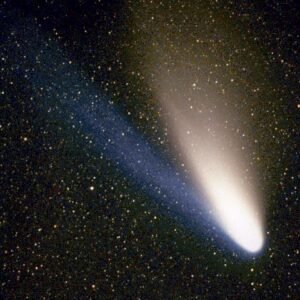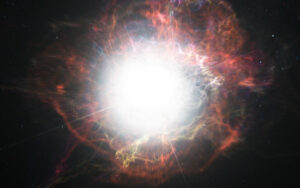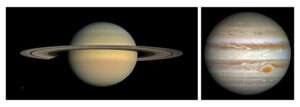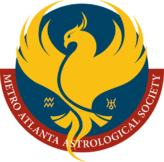The History of the Future
Nostradamus: How Did He Do It?
Tool 3: Ancient Hidden Astrology Books (Continued)

by Larry A. Filoso, February – September 2023, revised May 2024
In the previous part of this article, we took a journey through time from the libraries of ancient Egypt, through the Greeks like Plato to the Abbasid Renaissance in which science and astrology were reborn and written down by Abu Ma’shar, to the Medici secret hidden library in Italy which contained knowledge from all over the world and provided the birthplace of the European Renaissance.
All through this period, stargazers studied the grand conjunctions of Saturn and Jupiter, with Mars, to make long-term predictions. Nostradamus was one of these. He was even born during a conjunction, when those three planets lined up in space and looked close together in the night sky.
Twinkle Twinkle Little Star
In a previous article “Nostradamus Dates the End of the World” (published in two parts in February and March 2023), I revealed how he wrote about the ancient Greek astrologer Anaxagoras who had predicted a meteor. After it streaked through the sky and hit the ground, the townspeople put a sign on the large meteorite that had fallen which read “Anaxagoras Predicted This”. It became an instant tourist attraction. [34] Is it possible that astrology can predict astronomical events like meteors, comets and supernovae?
Nostradamus predicted, years in advance, two rare supernovae, and how their appearances would herald (and hasten) the end of the Renaissance in Europe. That period saw the weakening of the old religious world view and the beginning of our current scientific world view. He would not live to see the two exploding stars himself.
Michel de Nostredame (aka Nostradamus) wrote “I wanted to leave a record in writing of the years, towns, cities and regions in which most of the events will come to pass, even those of the year 1585 and of the year 1606…”. [Leoni, pg 327:5] [Bolded by your author – remember this year]
I’ll detail the first supernova which he predicted to occur in 1585 a little later in this text.
He also wrote, in Century 6, Quatrain 6 (which could be written in secret code as 6:06, or 1606):
There will appear towards the North
Not far from Cancer the bearded star:
Susa, Siena, Boetia, Eretria,
The great one of Rome will die, the night over.
To unpack this Quatrain, let’s first look at the key phrase “bearded star“.
In their Ancient Hidden Astrology Books, ancient astrologers used the term “bearded stars” because they were different from other stars. A “fixed star” was a solid spot of light in the night sky that basically stayed in the same position relative to the other fixed stars year-after-year, decade-after-decade. It did not change its size or appearance.
A “bearded star” had a solid spot of light like the fixed stars, but it also had a fuzzy, speckled or cloudy light (like a “beard”) around it which made it appear very different. A bearded star was not fixed; it visually changed over a period of days. After a short time, it disappeared. Today we know that they were referring to a “comet” or a “supernova”.

A Comet moves against the backdrop of the fixed stars. It has a spot of light in the middle. It also has a bright fuzzy area. Usually this stretches out from the central spot of light and appears like a long “tail”, but sometimes it looks like a fuzzy ring around the center.

Supernovae probably happen in the universe all of the time. But the ones that we can see from earth with the naked eye don’t happen that often, on average once every several hundred years. As a star begins to die, it explodes, creating a bright fuzzy ring around the light central core of the star.
For the first week or so, it may appear quite large, almost as big as our Sun. After that it begins to shrink and fade away. It may be dimly visible for months or even a year or two before completely disappearing.
Sometimes the supernova had been a “fixed star” visible for many years, but then exploded. Other times the star had been invisible, too faint to see, but became visible for a short time after it exploded.
Could Nostradamus have foreseen two supernovae appearing in the skies only a few decades apart? Even stranger, could he have made that prediction at a time when no one in Europe even knew what a supernova was, when everyone thought that the Earth was flat and that the heavens never changed?
Remember, Nostradamus predicted in Century 6, Quatrain 6 (in secret code as 6:06, or 1606):
There will appear towards the North
Not far from Cancer the bearded star:
Susa, Siena, Boetia, Eretria,
The great one of Rome will die, the night over.
Beginning in October 1604 and shining until 1606, a supernova did appear in the sky! It was so bright that for weeks it could be seen in broad daylight. It really freaked people out!
This exploding star was situated smack-dab in the middle of a Saturn/Jupiter/Galactic Center/Mars stellium (see the chart below). Those three planets were in Sagittarius, as the grand conjunction pattern began changing from Scorpio to the anchor sign of Sagittarius; from the Water element to Fire.
It was just North of the Ecliptic.
Unless “Not far from Cancer” was a secret code, that part of his prediction was wrong. The exploding star appeared in the constellation of Ophiuchus, in the Tropical sign of Sagittarius.
Siena is a town just south of Florence, the home of the Medici. Susa was a famous city in ancient Italy, Boeotia and Eretria are in Greece.
In 1605, while the supernova was still blazing, Alessandro de’ Medici (for whom Nostradamus had done astrological readings when Alessandro was young) suddenly died overnight only 26 days after becoming Pope Leo XI. “The great one of Rome will die, the night over.” [35] And the Renaissance was over.
He was the last of four Medici Popes. His death signaled the end of the Medici influence on the Roman Catholic Church, and the end of the Renaissance in mainland Europe. The Egyptian-Greco-Roman “Rebirth” (the English translation of the French word “Renaissance”) had begun in the late 1300’s.
By 1606 King James I of England was having the Catholic Bible translated into English (the “King James Version”) so that commoners could read it. This became the Holy Book, the center of Protestant Christian religions. In the Roman Catholic Church only the priests could read the Bible, because it was written in Latin, an ancient language that only a few could understand.
In 1606 colonists, working for King James’s new multi-national corporation The Virginia Company of London, departed England to create a new country far away across the seas from Rome, and founded a new city called Jamestown, Virginia. [36] This country eventually became the most powerful in the world, more powerful than the Roman Empire had been.

“So what about the first supernova that Nostradamus predicted?”, you might ask. “I wanted to leave a record in writing of the years, towns, cities and regions in which most of the events will come to pass, even those of the year 1585 and of the year 1606…”. Did a supernova appear before the one in 1604?
Yes, thirteen years earlier than Nostradamus had predicted, and six years after his death. It appeared in November 1572. It was a large bearded star in the constellation of Cassiopeia. No European had ever seen anything like it before.
There were 34 years between the two exploding stars, yet they were connected. Their appearances caused Astrology to give birth to Astronomy.
Astrology Gives Birth
For a short explanation of Astrology, click here.
Before the 15th century AD (CE), there were no astronomers like those today – only astrologers who studied the stars as a way to tell time. Astronomy, the specialized science of today, was spun off from astrology.
In fact, the procedures of observing, measuring, theorizing and experimenting were created by the first astronomers and started a trend. Others began to use this same protocol to study other aspects of Nature. These experts became known as “Scientists”.
Because historians have hidden that, most experts don’t realize that without astrology, we might have missed the progress of the past few centuries. In many ways, astrology birthed the other sciences.
Astronomers don’t study the heavenly bodies as a measure of time, nor to make predictions. Today’s astronomers study the physical and mechanical properties of celestial objects and Earth. Along with rocket scientists, they have opened a vast new frontier and the possibility of humans actually living on other planets.
If astrology is foretelling us that our planet is in for a “great reboot” of human civilization, and then over a thousand years later that Earth may become uninhabitable to today’s type of human, then moving to other planets may be the only hope of our species surviving it, as Nostradamus implies.
So, how did this birth come about?
In 1572 a Danish astrologer Tycho Brahe noticed a strange new object in the night sky, looking like a “bearded star”. It motivated him to record detailed observations of the heavens. He built the first large observatory in Christian Europe and called it Uraniborg (“castle of the heavens”). [37]
Based upon his groundbreaking observations and calculations, Brahe improved the flawed ephemerides astrologers had been using.
The publication in 1573 of De nova stella (“About the New Star”), his observations of that supernova, made Tycho Brahe a superstar in Europe.
In 1600 Brahe moved to Prague, a center of astrology, and took with him his volumes of observations. There he chose, as one of his assistants, another astrologer, Johannes Kepler. The following year Brahe mysteriously died after attending a banquet, and Kepler took his notes.

Astrologers in Protestant Prague had been studying the Ancient Hidden Astrology Books of Abu Ma’shar, the Abbasid scholar whom I wrote about in Tool 3. He had predicted that a bearded star would appear around 1603 as the 240-year pattern of Saturn/Jupiter grand conjunctions moved into the fire sign of Sagittarius. Kepler was also aware of Michel de Nostredame’s 50-year-old prophecies about 1585 and 1606 (which I wrote about earlier).
Abu Ma’shar, Nostradamus and Kepler were all aware that in 1603 the pattern of Saturn/Jupiter grand conjunctions would begin moving into the Fire sign of Sagittarius. Could this mean a new “ball of fire” would appear in the sky?
From Prague, Kepler began patiently observing the Saturn/Jupiter conjunction in 1603. He was eagerly awaiting a supernova. He was not disappointed. [38]
He saw and accurately recorded the bearded star that appeared in 1604 that now bears his name. Abu Ma’shar had predicted it would appear in 1603, and Nostradamus had predicted it for 1606.
Kepler studied Tycho Brahe’s hyper-accurate ephemerides. He calculated that a grand conjunction of Saturn and Jupiter had occurred around 4 BCE, and immediately connected this with the unusual star which had been followed by the three wise men. Could it have been a supernova?
In 1614 he theorized that these special grand conjunctions actually caused supernovae. He thought that the conjunction of 1603 caused the supernova of 1604, and the joining of Saturn/Jupiter two 800-year cycles before had caused an exploding star, the Star of Bethlehem. [39]
Tycho Brahe had become famous because of his book about the first supernova which had appeared in 1572 that Nostradamus had predicted. Brahe’s former assistant Johannes Kepler became famous because of Kepler’s book about the second supernova (1604) that Nostradamus had predicted.
Together they launched the Scientific Revolution and birthed the modern science of Astronomy. Not too shabby!
The astronomer’s main tool, the telescope, is believed to have been invented in 1608. After the two supernovae changed the heavens, experts sought a better way to see and study the stars.
But back in Italy, things were heating up.
Nostradamus had predicted that the open-minds of the Renaissance in mainland Europe would only last for a while, perhaps until the death of the last of four Medici Popes in 1605.
In Century 8, Quatrain 71 he wrote:
Will increase greatly the number of astronomers,
Driven out, banished, and books censored;
The year 1607 by sacred assemblies,
That none of them will be safe.
And that’s what happened. Notice he didn’t write astrologers, he wrote astronomers, as if he knew that Astronomy would be born around 1607, and that astronomers would be persecuted.
Around 1500, the Polish astrologer-turned-astronomer Nicolaus Copernicus developed his own Crazy Weird Theory: that the Earth, planets, and stars all revolved around the Sun, rather than the official view that all the others revolved around a flat Earth. He was afraid of ridicule and reprisals. His radical theories were only circulated in secret societies and at the Medici hidden library, until much later. [40]
An Italian, Galileo Galilei, at first opposed Copernicus’s ideas. But by 1610 his studies had convinced him that Copernicus had been right, and he began to publicly lecture about heliocentrism. Because of that, in 1613 Galileo was first accused of heresy, and by 1633 the Papal Inquisition (“sacred assemblies“) found him guilty. They sentenced him to house arrest for the remainder of his life. [41]
Not even Galileo’s patrons the Medici could help the astronomers. The Inquisition censored all books about heliocentrism, astrology and astronomy, infant science and Greek humanism. Practitioners went underground in secret societies. “The year 1607…That none of them will be safe.”
It is human nature to cling to old, comfortable ideas, and the officials in the Inquisition were human beings.
In 1620 the army of the Catholic League, as part of “The Thirty Years War”, conquered Protestant Prague, bringing about the divorce of the two parts of Christendom. Protestantism moved to England and Sweden and got custody of science, astronomy and astrology; and Catholicism retained custody of the remainder of Europe.
By the way, in 1607 (the year specified in the Quatrain above), the other kind of “bearded star” also appeared. This one returns to Earth about every 76 years. Today, astronomers call it “Halley’s Comet”.
On its third visit after 1607, in 1835, the great (and my favorite) American writer Mark Twain was born. In 1910 on its next return, Mark Twain died. He had always said, “I rode in on Halley’s comet, and I’ll ride out on it”. It was last visible in 1986 and will return in 2061.
In 2060 the Saturn/Jupiter grand conjunction in the sign of Gemini (“the Twins”). It’s predicted that this time we will see twin tails. [42]
Concerning the return of science to the mainland of Europe, Nostradamus saw light at the end of the tunnel. Writing about the year 1792 he said, “after this the Roman people will begin to chase away the obscure shadows…” [Leoni, pg 341:43] …and science and technology would develop again as it had in Greek and Roman times. Many terms used in medicine and other sciences today are in Latin, the language of the Romans.
I’d like to end this part of the article with these predictions:
Nostradamus mentions bearded stars in other Quatrains. For instance, in Century 2 Quatrain 41:
The big star for seven days will burn,
The beard [around it] will make two suns to appear:
The fat war dog all night will howl
When the big [Roman] high priest will change territory.
In line 2, the French word which I translated as “beard” (Nuée), the bright fuzzy area around the center of the supernova, would make it look much larger in the sky, maybe as big as the Sun – two suns to appear.
My intuition tells me that we will see several exploding stars over the next century, timed by the future grand conjunctions.
I think that in this Quatrain, Nostradamus forecasted an upcoming supernova. Many of us reading this may get to see it. In secret code, Century 2, Quatrain 41 could be written as 2:41, or 2041. I estimate that it could occur around September 9, 2040. The next chance happens near June 2060.
Around September 2040 there will be a stellium of Saturn, Jupiter, Mars, Venus, Mercury and the Moon in Libra. In June 2060 Neptune, Saturn, Jupiter, Mars, and the Sun will conjunct in Gemini, square Pluto in Pisces.
In February 2080 Saturn, Jupiter, Venus, Mercury, and the Sun will all gather in Aquarius. Uranus, the planetary ruler of Aquarius, will join with the grand conjunction of Saturn and Jupiter on February 1st. At the end of October, Mars will join with those three. Opposing them will be Neptune in Leo. Look for a supernova in Aquarius or Leo.
But the highest chance this century for a large visible supernova, I would put the probability at 90%, occurs in February 2080.
The following solar eclipse on the first day of Spring in the same year may see “burning stones raining down from the sky”. People living then may experience another minor shift in Earth’s axis of rotation as occurred during the major earthquakes in 2004 and 2011, which caused Earth’s rotation to speed up and days to get shorter. Humans, including an astronaut named O’Brien, may have made it to Mars.
My intuition points to three candidate stars to explode. They are some of the largest ones in our galaxy. The first of these is Betelgeuse, a red super-giant sun in the constellation of Orion, in the sign of Gemini. A million of our Suns could fit inside of it.
For the ancient Egyptians, one of the two most important places in the heavens was the constellation Osiris (Orion). They believed that the soul of their first King, Osiris, came from and returned to one of the stars in that star-group. Ancient Mayan astrologers also believed their civilization came from Orion.
In the 3rd line of his Quatrain, Nostradamus might have hinted that he thought a supernova would appear in or near one of the dog constellations, Canis Major or Minor. The “Dog Star” Sirius, the other point in the sky important to the ancient Egyptians, is in Canis Major, in the Water sign of Cancer and is my second candidate.
Near that constellation is another red super-giant star, Canis Majoris. This is my third candidate.
In Tool 4 we ask, “Could Nostradamus have actually possessed an advanced scientific device, and helped to shape the changes he was predicting?” Next time, in
The History of the Future, Nostradamus: How Did He Do It?
References, Citations and Notes
All charts and planetary positions were calculated using Solar Fire version 9 in Windows.
For citations from Edgar Leoni’s book, one of my main references, I specify the Century and Quatrain numbers for poems, or Page:Paragraph numbers for prose writings. Within my text, direct quotations from Nostradamus are printed in Red, usually with the citation source next to the quotation for easy reference.
Nostradamus: How Did He Do It? Tool 3 (Continued) was published in the American Federation of Astrologers magazine “Today’s Astrologer” in the April 8, 2024 edition, Volume 86, Number 4.
The AFA was founded in 1938 to promote the art and science of astrology through education and research. It was the first American national astrological organization to administer certification examinations to encourage a high standard of professional ethics among astrologers.
